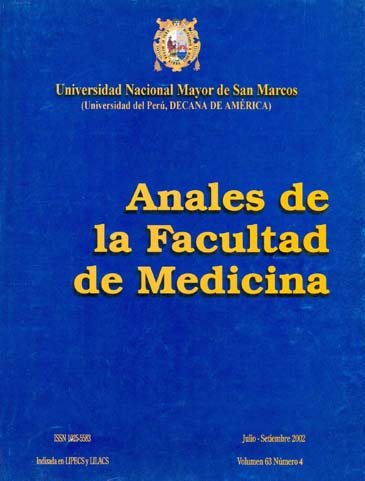Hydatidiform mole clinical and pathological characteristics
DOI:
https://doi.org/10.15381/anales.v63i4.1514Keywords:
Hydatidiform mole, pregnancy complications, uterine neoplasmsAbstract
Objective: To determine clinical and pathological findings in hydatidiform mole. Design: Descriptive retrospective study. Material and methods: All cases de molar pregnancy attended at Dos de Mayo National Hospital (HNDM) between 1998 and 2001 were reviewed. Results: Twenty-four cases of hydatidiform mole were attended; mean age was 26,4 years ± 6,4 and gestational age 13,1 weeks ± 3,3. Past history only showed 1 and 3 cases of hyperemesis gravidarum and previous abortions, respectively; 18 pregnant women were multiparae. Symptoms on admission were hypogastric pain (75%), nausea and vomiting (29,2%), dysuria (20,8%) and headache (8,3%); and clinical sigsn, fetal absence (100%), vaginal bleeding (91,7%), soft uterus (45,8%), discordant uterine height (33,3%) and expulsion of vesicles (25%). Ultrasound diagnosis was hydatidiform mole with fetal absence (100%), ovarian enlargement (29,2%) and tecaluteinic cysts (25%). Average βhCG was 18167 UI/L. Transvaginal misoprostol was used previouly to dilatation and curettage in 37,5%. Pathology findings were corionic epitheliu moderate hyperplasia (62,5%), avascular estroma (50%) and edematous villi (20%). Conclusion: Our findings denote infrequent characteristics to the literature description on this pathology.Downloads
Published
2002-12-30
Issue
Section
Trabajos originales
License
Copyright (c) 2002 JOSÉ PACHECO D, JAIME ALEGRE, GISSELA PANIAGUA

This work is licensed under a Creative Commons Attribution-NonCommercial-ShareAlike 4.0 International License.
Those authors who have publications with this magazine accept the following terms:
- Authors will retain their copyrights and guarantee the journal the right of first publication of their work, which will be simultaneously subject to Creative Commons Attribution License that allows third parties to share the work as long as its author and its first publication this magazine are indicated.
- Authors may adopt other non-exclusive licensing agreements for the distribution of the version of the published work (eg, deposit it in an institutional electronic file or publish it in a monographic volume) provided that the initial publication in this magazine is indicated.
- Authors are allowed and recommended to disseminate their work over the Internet (eg: in institutional telematic archives or on their website) before and during the submission process, which It can produce interesting exchanges and increase quotes from the published work. (See El efecto del acceso abierto ).
How to Cite
1.
Pacheco D. J, Alegre J, Paniagua G. Hydatidiform mole clinical and pathological characteristics. An Fac med [Internet]. 2002 Dec. 30 [cited 2024 Jul. 17];63(4):275-80. Available from: https://revistasinvestigacion.unmsm.edu.pe/index.php/anales/article/view/1514















